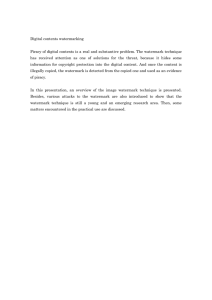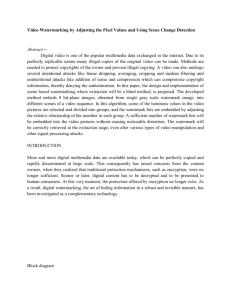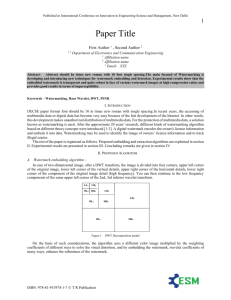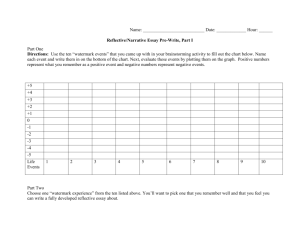in Proceedings of the IEEE International Conference
advertisement
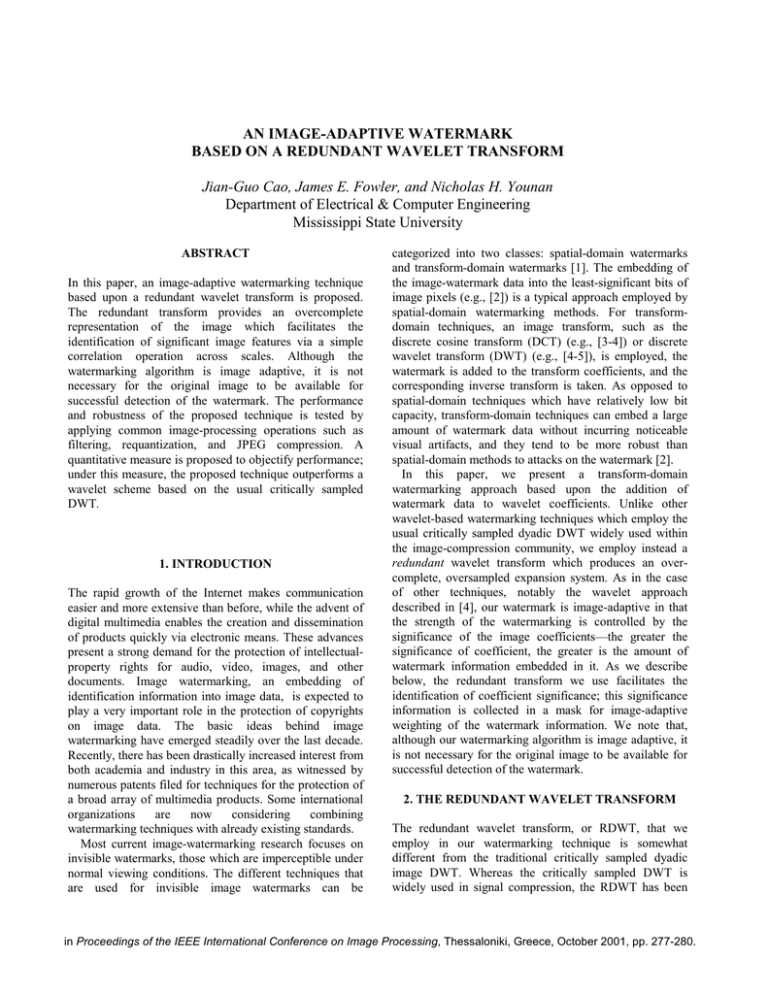
AN IMAGE-ADAPTIVE WATERMARK
BASED ON A REDUNDANT WAVELET TRANSFORM
Jian-Guo Cao, James E. Fowler, and Nicholas H. Younan
Department of Electrical & Computer Engineering
Mississippi State University
ABSTRACT
In this paper, an image-adaptive watermarking technique
based upon a redundant wavelet transform is proposed.
The redundant transform provides an overcomplete
representation of the image which facilitates the
identification of significant image features via a simple
correlation operation across scales. Although the
watermarking algorithm is image adaptive, it is not
necessary for the original image to be available for
successful detection of the watermark. The performance
and robustness of the proposed technique is tested by
applying common image-processing operations such as
filtering, requantization, and JPEG compression. A
quantitative measure is proposed to objectify performance;
under this measure, the proposed technique outperforms a
wavelet scheme based on the usual critically sampled
DWT.
1. INTRODUCTION
The rapid growth of the Internet makes communication
easier and more extensive than before, while the advent of
digital multimedia enables the creation and dissemination
of products quickly via electronic means. These advances
present a strong demand for the protection of intellectualproperty rights for audio, video, images, and other
documents. Image watermarking, an embedding of
identification information into image data, is expected to
play a very important role in the protection of copyrights
on image data. The basic ideas behind image
watermarking have emerged steadily over the last decade.
Recently, there has been drastically increased interest from
both academia and industry in this area, as witnessed by
numerous patents filed for techniques for the protection of
a broad array of multimedia products. Some international
organizations
are
now
considering
combining
watermarking techniques with already existing standards.
Most current image-watermarking research focuses on
invisible watermarks, those which are imperceptible under
normal viewing conditions. The different techniques that
are used for invisible image watermarks can be
categorized into two classes: spatial-domain watermarks
and transform-domain watermarks [1]. The embedding of
the image-watermark data into the least-significant bits of
image pixels (e.g., [2]) is a typical approach employed by
spatial-domain watermarking methods. For transformdomain techniques, an image transform, such as the
discrete cosine transform (DCT) (e.g., [3-4]) or discrete
wavelet transform (DWT) (e.g., [4-5]), is employed, the
watermark is added to the transform coefficients, and the
corresponding inverse transform is taken. As opposed to
spatial-domain techniques which have relatively low bit
capacity, transform-domain techniques can embed a large
amount of watermark data without incurring noticeable
visual artifacts, and they tend to be more robust than
spatial-domain methods to attacks on the watermark [2].
In this paper, we present a transform-domain
watermarking approach based upon the addition of
watermark data to wavelet coefficients. Unlike other
wavelet-based watermarking techniques which employ the
usual critically sampled dyadic DWT widely used within
the image-compression community, we employ instead a
redundant wavelet transform which produces an overcomplete, oversampled expansion system. As in the case
of other techniques, notably the wavelet approach
described in [4], our watermark is image-adaptive in that
the strength of the watermarking is controlled by the
significance of the image coefficients—the greater the
significance of coefficient, the greater is the amount of
watermark information embedded in it. As we describe
below, the redundant transform we use facilitates the
identification of coefficient significance; this significance
information is collected in a mask for image-adaptive
weighting of the watermark information. We note that,
although our watermarking algorithm is image adaptive, it
is not necessary for the original image to be available for
successful detection of the watermark.
2. THE REDUNDANT WAVELET TRANSFORM
The redundant wavelet transform, or RDWT, that we
employ in our watermarking technique is somewhat
different from the traditional critically sampled dyadic
image DWT. Whereas the critically sampled DWT is
widely used in signal compression, the RDWT has been
in Proceedings of the IEEE International Conference on Image Processing, Thessaloniki, Greece, October 2001, pp. 277-280.
proposed for signal detection and enhancement [6,7], since
the RDWT maintains uniform sampling rate in the time
domain and is in some respects a discrete approximation
to the continuous wavelet transform. In practice, the
RDWT is implemented via the “algorithme à trous” [6]—
in brief, instead of downsampling the lowpass signal
during each filter-bank iteration as is done in the usual
DWT, the filters themselves are upsampled before
performing filter convolution at each scale.
The redundancy of the RDWT facilitates the
identification of salient features in an image, especially
image edges. Specifically, the direct multiplication of the
RDWT coefficients at adjacent scales distinguishes
important features from the background due to the fact that
wavelet-coefficient magnitudes are correlated across
scales. Coefficient-magnitude correlation is well known to
exist in the usual critically sampled DWT also; however,
the changing temporal sampling rate makes the calculation
of an explicit correlation mask across scales much more
difficult for the critically sampled DWT [7].
3. THE RDWT WATERMARKING ALGORITHM
The redundancy in the RDWT permits simple signal
denoising using a correlation mask created by direct
multiplication of subband signals [7]. To some extent,
image watermarking can be viewed as the inverse process
of image denoising—in image watermarking, the
watermark, which can be consider as “noise,” is added to
the original image. The goal is that the added “noise” be
invisible to the human visual system (HVS) and difficult to
remove by intentional or non-intentional image operations.
The RDWT aids the watermarking process by providing a
mask to guide where the watermark is added.
In our technique, white Gaussian noise is used as a code
sequence (the watermark); this noise is added to the
RDWT coefficients of the image, according to:
f {V' , H ,D} ( x, y ) = f {V ,H ,D} ( x, y )
+ αv{V ,H , D} ( x, y ) w{V ,H ,D} ( x, y )
(1)
where
f {V , H , D} ( x, y ) are the RDWT coefficients of the
image,
v{V , H , D} ( x, y ) are the added watermarks, and V,
H, and D stand for the vertical, horizontal, and diagonal
components respectively. The parameter α controls the
strength of the watermarks, and
w{V , H , D} ( x, y ) are the
correlation weighting masks for the vertical, horizontal,
and diagonal components. Eq. 1 guarantees that the added
watermark is robust by embedding it in the significant
features of the image; the location of the significant
features are given by the correlation mask. In our
technique, the correlation mask is created as
i
wi{V ,H ,D } ( x, y ) = ∏ f * j{V , H ,D} ( x, y ) ,
(2)
j =1
where
f j*{V , H , D} are the normalized RDWT coefficients
at scale j of the transform, i.e.,
f j*{V ,H ,D} =
f j{V ,H ,D} ( x, y ) ⋅ f j{V ,H ,D} ( x, y )
M −1 N −1
∑∑
,
(3)
f j{V ,H ,D } ( x, y ) 2
x = 0 y =0
wi{V ,H ,D } ( x, y ) is the correlation mask obtained from
scale 1 through scale i of the transform. We note that
and
calculation of the correlation mask in this manner is
possible due to the fact that each RDWT subband is the
same size as the original image.
The detection of the existence of the watermark is
simply an inverse process. That is, after taking the RDWT
of the image, a simple correlation method is used to detect
the similarity and identify the watermark. Specifically, the
similarity is
ρ = max {S =V ,H ,D } ρ S ,
(4)
[ ]
where
ρS =
M −1 N −1
∑∑ f
'
S
( x, y )v S ( x, y )
(5)
x =0 y = 0
'
is the similarity measure for subband s, f S ( x, y ) are the
RDWT coefficients of the image to be tested, and
v S ( x, y ) are the watermarks added to the vertical,
horizontal, or diagonal subbands. ρ corresponds to the
maximum similarity coefficient from each of the different
orientations, which makes our technique robust to attacks
that affect the orientations differently [4]. Here, it is
assumed that the image size is M×N.
The above detection scheme does not require that the
original image, f S ( x , y ) , be available at the detector.
However, if the original image can be used in detection, a
modified similarity measure can be used in place of Eq. 5.
That is,
ρS =
M −1 N −1
∑∑ [ f
'
S
( x, y ) − f S ( x, y )]v S ( x, y ) . (6)
x = 0 y =0
provides similarity for subband s in this case, while Eq.4 is
employed unchanged.
4. EXPERIMENTAL RESULTS
For the experimental results described in this section, our
RDWT watermarking technique employs a two-scale,
separable 2D RDWT using length-4 Daubechies wavelet
filters. Coefficients of the first scale (highest-frequency H,
V, and D subbands) are watermarked, while the mask
in Proceedings of the IEEE International Conference on Image Processing, Thessaloniki, Greece, October 2001, pp. 277-280.
w{V , H , D} ( x, y ) is obtained from multiplying the
appropriate subbands from both scales. The parameter α
that controls the strength of the added watermark is
selected so to achieve a given PSNR. We compare the
performance of our RDWT technique to another technique
by adjusting the strength of the watermarking so that the
same PSNR is obtained for both techniques. Fig. 1 shows
the masks w{V , H , D} ( x, y ) for lenna.
We compare our RDWT technique to another transformdomain technique intended to be representative of the
typical approach based on the usual critically sampled
DWT. Specifically, we use the approach proposed in [4],
except that the subband weights, w{V , H , D} ( x, y ) , are the
just-noticeable distortion (JND) values tabulated in [8],
which have been widely used in perceptually based imagecompression applications. In this case, watermarking is
equivalent to Eq. 1 except that the transform is now
critically sampled and the subband weights are not image
adaptive but are, rather, constant across each subband.
Again, we use the length-4 Daubechies filter, and Eqs. 4
and 5 provide watermark detection.
In both techniques, the watermark strength is adjusted
as needed to obtain a given PSNR (for these experiments,
approximately 34dB for lenna). White Gaussian noise with
zero mean and unit variance is used as the added
watermark.
The detector responses for the two techniques are given
in Fig. 2, wherein we have 1000 different watermarks, and
the correct mark is mark 200. In order to give a
quantitative measure of detection performance, we
propose a “peak-response gain” measure which we define
as
N
G = N * {max n [ ρ ( n )]} / ∑ ρ ( n ) 2
2
n =1
(6)
where ρ (n) is the detector response for trial n and N is
the number of total trials. This peak-response gain gives a
measure of how large the detector response to the correct
mark is in relation to the average response for incorrect
marks. This measure provides an indication of how
difficult it is to detect the correct-mark peak—the larger
the peak-response gain, the easier it is to set a threshold
for mark detection. Table 1(a) shows the peak-response
gains for the RDWT and DWT techniques.
The robustness of the watermarking techniques is tested
through general image processing methods such as
lowpass filtering (5×5 spatial averaging), requantization
(8-level uniform scalar quantization), and lossy
compression (JPEG with a quality factor of 15). The peakresponse gain performance for these degradation
operations are shown for two techniques in Tables 1(b)-
(d). We note that our RDWT technique consistently
outperforms the DWT technique.
5. CONCLUSION
In this paper, an image-adaptive watermarking technique
based on a redundant wavelet transform is presented. By
using the direct product of the wavelet coefficients at
different scales as a significance mask, this technique can
embed the invisible watermark into salient features of the
image thus ensuring robustness to subsequent imageprocessing operations that may be used to attack the
watermark. A quantitative measure is proposed to
objectify performance; under this measure, the proposed
technique outperforms a wavelet scheme based on the
usual critically sampled DWT.
6. REFERENCES
[1] R. B. Wolfgang, C. I. Podilchuk, and E. J. Delp,
“Perceptual Watermarks for Digital Images and Video,”
Proc. IEEE, vol. 87, no. 7, pp. 1108-1126, Jul. 1999.
[2] R. G. van Schyndell, A. Z. Tirkel, and C. F. Osborne, “A
Digital Watermark,” in Proc. ICIP, Austin, TX, Nov. 1994,
pp. 86-89.
[3] I. J. Cox, J. Kilian, F. T. Leighton, and T. Shamoon,
“Secure Spread Spectrum Watermarking for Multimedia,”
IEEE Trans. Image Proc., vol. 6, no. 12, pp. 1673-1687,
Dec. 1997.
[4] C. J. Podilchuk and W. Zeng, “Image-Adaptive
Watermarking Using Visual Models,” IEEE Journal
Selected Areas Comm., vol. 16, no. 4, pp. 525-539, May
1998.
[5] M. Barni, F. Bartolini, and A. Piva, “Improved WaveletBased Watermarking Through Pixel-Wise Masking,” IEEE
Trans. Image Proc., vol. 10, no. 5, pp. 783-791, May 2001.
[6] S. Mallat and S. Zhong, “Characterization of Signals from
Multiscale Edges,” IEEE Trans. Pattern Anal. Machine
Intelligence, vol. 14, no. 7, pp. 710-732, Jul. 1992.
[7] Y. Xu, J. B. Weaver, D. M. Healy, Jr., and J. Lu, “Wavelet
Transform Domain Filters: A Spatially Selective Noise
Filtration Technique,” IEEE Trans. Image Proc., vol. 3, no.
6, pp.747-758, Nov. 1994.
[8] I. Höntsch, L. J. Karam, and R. J. Safranek, “A Perceptually
Tuned Embedded Zerotree Image Coder,” in Proc. ICIP,
Santa Barbara, CA, Oct. 1997, pp. 41-44.
in Proceedings of the IEEE International Conference on Image Processing, Thessaloniki, Greece, October 2001, pp. 277-280.
Technique
DWT
RDWT
PRG
835.6
996.4
(a)
Technique
DWT
RDWT
PRG
9.8
147.9
(b)
Technique
DWT
RDWT
PRG
827.1866
994.6259
(c)
Technique
DWT
RDWT
PRG
9.5228
649.0675
(d)
Table 1. The peak-response gain (PRG) for the
watermarked lenna image (a) without any operation, (b)
with filtering, (c) with requantization, (d) with JPEG
compression
Figure 1. Correlation masks from the RDWT
watermarking technique for lenna (vertical, horizontal, and
diagonal masks, respectively, top to bottom)
2000
900
800
700
Detector Response
Detector Response
1500
1000
500
600
500
400
300
200
0
100
0
-500
0
100
200
300
400
500
N
(a)
600
700
800
900
1000
-100
0
100
200
300
400
500
N
600
700
800
900
1000
(b)
Figure 2.Detector response for watermarked lenna image (a) DWT, (b) RDWT
in Proceedings of the IEEE International Conference on Image Processing, Thessaloniki, Greece, October 2001, pp. 277-280.
